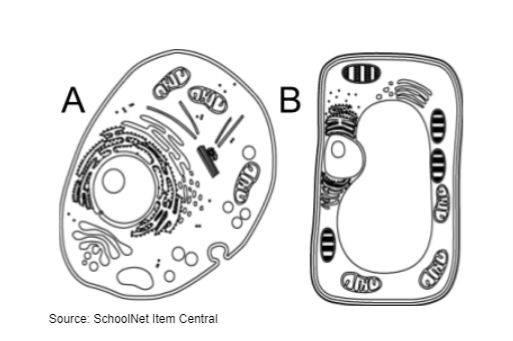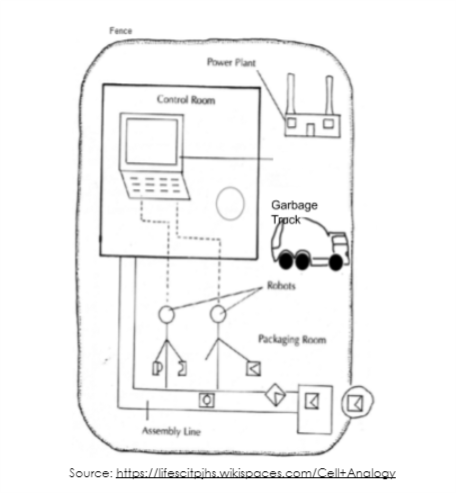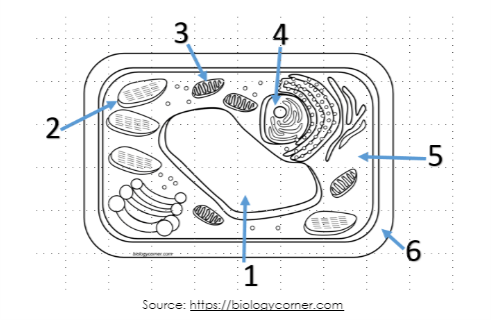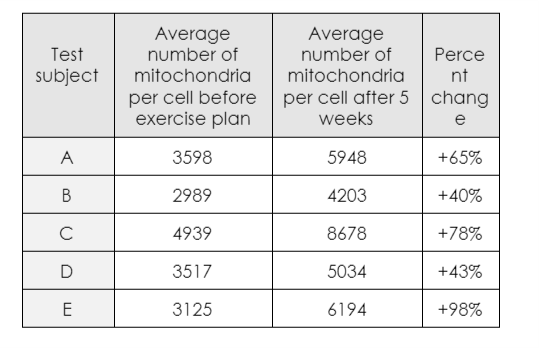A student has a robotic vacuum cleaner at his house. It turns on at the push of a button. It changes direction when it senses it is getting near a wall and changes power level when it goes from carpet to hardwood floor. It learns where the stairs and drop-offs are in their house so it doesn’t fall down. The robot vacuum even goes back to its charging station when its energy level is low to recharge itself.
Which of the following arguments is correct regarding if the vacuum is living or non-living?
A.The robot vacuum is alive because it moves and obtains new information.
B.The robot vacuum is alive because it responds to stimuli and uses energy.
C.The robot vacuum is not alive because it is not made of cells and cannot reproduce.
D.The robot vacuum is not alive because it does not grow and develop and does not require oxygen.
C.The robot vacuum is not alive because it is not made of cells and cannot reproduce.
Lysosomes are important organelles within a cell. What would most likely happen if a cell’s lysosomes were not functioning properly?
The cell would be damaged because it could not get rid of waste and toxins
Which of the following choices is the best example of how the cell membrane and mitochondria might work together to release energy in a particular cell?
A. In animal cells, the cell membrane allows materials in and out of the cell, while the mitochondria uses nutrients to make energy for the cell.
B. In animal cells, the mitochondria allows materials in and out of the cell, while the cell membrane uses nutrients to make energy for the cell.
C. In a plant cell, the cell wall allows materials in and out of the cell, while the mitochondria makes food for the cell by photosynthesis.
D. In a plant cell, the mitochondria allows materials in and out of the cell, while the cell wall makes food for the cell by photosynthesis.
A. In animal cells, the cell membrane allows materials in and out of the cell, while the mitochondria uses nutrients to make energy for the cell.
A scientist is examining slides of cells from organisms in different groups. What two features would the scientist use to distinguish a plant cell from an animal cell?
A. presence or absence of a nucleus and cell membrane
B.presence or absence of mitochondria
C. presence or absence of a cell wall and chloroplasts
D.presence or absence of a cell membrane and cytoplasm
C. presence or absence of a cell wall and chloroplasts

Which statement best describes models A and B above?
A. Model A is an animal cell and model B is a plant cell because model A contains a nucleus in the center of the cell and model B contains a nucleus near the edge.
B. Models A and B are both plant cells because they both contain a nucleus, mitochondria.
C. Model A is an animal cell and model B is a plant cell because model B contains a chloroplasts and a cell wall, all of which model A does not have.
D. Models A and B are both animal cells because they both contain a nucleus and mitochondria.
C. Model A is an animal cell and model B is a plant cell because model B contains a chloroplasts and a cell wall, all of which model A does not have.
A student is using a microscope to observe samples taken from pond water. She notices something that she thinks may be a living thing. Which argument would BEST support that the unknown sample is a living thing?
a. The sample was moving, so it must be alive, because all living things respond to their environment.
b.The sample has cells, so it must be alive, because all living things are made up of one or more cells.
c. The sample is green, so it must be alive, because plants are green and they are alive.
d. The sample was producing bubbles, so it must be alive, because only living things can have chemical reactions that would release gases.
b.The sample has cells, so it must be alive, because all living things are made up of one or more cells.
You are looking at cells under the microscope. You notice one type of cell has many more lysosomes than the others. Your teacher said white blood cells have lots of lysosomes. Why would the white blood cells have an abundance of lysosomes?
A. White blood cells have many lysosomes because they need lots of ATP to help carry oxygen.
B. White blood cells have many lysosomes because they need to produce lots of proteins to help build muscle.
C. White blood cells have many lysosomes because they need to produce a lot of glucose and oxygen.
D. White blood cells have many lysosomes because they need to destroy pathogens with digestive enzymes
D. White blood cells have many lysosomes because they need to destroy pathogens with digestive enzymes
You and your friend are exercising after school. Your friend states that your body is converting food into energy when you run. He also knows that obtaining energy from food produces waste that can be toxic to your cells. However, he is not sure what organelles work together to provide energy to muscles cells and help those cells get rid of waste products. Which of the following answers will help your friend complete his explanation?
A. The chloroplast stores waste in an animal cell and at some point the waste leaves the cell through the cell membrane.
B. The lysosome releases energy from food and eventually the waste leaves the cell through the cell membrane.
C. The mitochondria release energy from food and later the waste exits the cell through the cell membrane.
D. The cytoplasm provides structure and aids in transporting waste from the inside of the cell to the outside of the cell through the cell wall.
C. The mitochondria release energy from food and later the waste exits the cell through the cell membrane.
The student identifies the cells as plant cells since she identifies a cell wall? She is asked to develop a more in-depth model of the cells she observed and include organelles found in plant cells that help the cell obtain and use energy. Which two organelle(s) should be included?
A. chloroplasts but not mitochondria
B. mitochondria and chloroplasts
C. mitochondria but not chloroplast
D. lysosomes and cytoplasm only
B. mitochondria and chloroplasts

What kind of cell does this model represent? How do you know?
An animal cell because there is no cell wall and no chloroplast.
A team of scientists think they discovered a new organism while exploring Brazil. Upon bringing the specimen back to their lab in Atlanta, they observe the specimen for several weeks. They take a sample from the specimen to observe it under a microscope and see the sample is composed of many small compartments containing what appears to be nuclei. They shine a bright light to the left of the specimen and observe it slowly turn itself towards the light over multiple days.
What further evidence would support that the newly discovered specimen is alive?
a. The specimen appears to be breathing.
b.The specimen observed under the microscope contain various organelles.
c. When placed in pure water, the specimen seems to swell up, absorbing the water.
d. The specimen grows in size and develops colorful blooms over the several weeks in which it is being observed.
d. The specimen grows in size and develops colorful blooms over the several weeks in which it is being observed.
Use the passage to answer the question that follows:
On a train, the conductor controls the speed of the train and decides when and where it stops. The train doors allow passengers and materials to get in and out of the train. The dining car makes food for the passengers. The luggage car stores luggage, freight, and other materials. The locomotive engine provides power for the train to run.
If you were asked in science class to use this analogy of a train to create a model that shows how the parts of a train are analogous to the parts of a cell, you would say that the train door is analogous to which part of the cell?
Cell Membrane because it lets things in and out
Patients with a genetic condition known as cystic fibrosis struggle with symptoms such as lung and digestive problems. At the cellular level, the cells of patients with the disease do not transport water or other materials out of the cell efficiently. Therefore, patients’ cells have a build up of water and other substances inside the cell. Which of the following best describes how cystic fibrosis impacts cells?
A. Cystic fibrosis affects the cell membrane increasing cellular transport and homeostasis
B. Cystic fibrosis affects the lysosomes increasing cellular transport and homeostasis
C. Cystic fibrosis affects the Golgi decreasing cellular transport and homeostasis
D. Cystic fibrosis affects the cell membrane decreasing cellular transport and homeostasis
D. Cystic fibrosis affects the cell membrane decreasing cellular transport and homeostasis
Plant and animal cells have many organelles in common such as the cell membrane. However, the function of the cell membrane differs between the plant and the animal cell. Which best describes how the function of the cell membrane differs in plant and animal cells?
A. In animal cells, the cell membrane is the outermost layer of the cell, while in plant cells the cell membrane separates the cell wall from everything else inside the cell.
B. In plant cells, the cell membrane is the outermost layer of the cell, while in animal cells, the cell membrane separates the cell wall from everything inside the cell.
C. In animal cells, the cell membrane controls what comes in and out of the cell, while in plant cells, the cell membrane houses all the genetic material.
A. In animal cells, the cell membrane is the outermost layer of the cell, while in plant cells the cell membrane separates the cell wall from everything else inside the cell.
A student was asked to compare various organelles to things in a house.

Which of the following would best improve the student’s model?
A. He should have used a strainer rather than a cardboard box because a strainer isn’t rigid and lets things in and out easily
B. He should have used a generator instead of a remote control because the generator provides energy for the house to function.
C. He should have used a refrigerator instead of a battery because a refrigerator stores food which is used for energy.
D. He should have used a storage room instead of a garbage disposal because a storage room stores things that are not needed in the house
A. He should have used a strainer rather than a cardboard box because a strainer isn’t rigid and lets things in and out easily
A student went to the park and found a round, foreign object laying on the ground. When the student got closer, they noticed the object was breathing. They reached out to touch it, and it rolled away from them. They finally caught the object and took the object home to observe it closer. One week later, the student noticed that the organism had increased in size and was able to make sounds in an effort to communicate with them.
What piece of evidence would help the student argue that the organism is a living thing?
The student noticed that the organism had increased in size and was able to make sounds in an effort to communicate with them which means it was growing and developing.
Use the passage to answer the question that follows:
On a train, the conductor controls the speed of the train and decides when and where it stops. The train doors allow passengers and materials to get in and out of the train. The dining car makes food for the passengers. The luggage car stores luggage, freight, and other materials. The locomotive engine provides power for the train to run.
A student says the locomotive engine must represent the chloroplast in a plant cell. Is the student correct? Explain.
No because chloroplast makes the glucose which the mitochondria uses to make energy
Four students discussed how the organelles of an animal cell contribute to the process of removing waste. Use their explanations to answer the question below.
Student A: When waste is produced by the cell, the nucleus gives instructions for waste removal to occur in the cell. The mitochondria breaks down the waste, the cytoplasm moves the waste from the lysosome to the cell membrane, which releases it from the cell.
Student B: When waste is produced by the cell, the nucleus gives instructions for waste removal to occur in the cell. The lysosome breaks down the waste and the cell membrane releases it from the cell.
Student C: When waste is produced by the cell, the nucleus gives instructions for waste removal to occur in the cell. The mitochondria breaks down the waste and the cell membrane releases it from the cell.
Student D: When waste is produced by the cell, the nucleus gives instructions for waste removal to occur in the cell. The lysosome breaks down the waste, the cytoplasm allows the waste to move across the cell from the lysosome to the cell membrane, which releases it from the cell.
Which student’s explanation is most complete in describing how organelles work together to remove waste?
Student D
Which of the following best explains what would happen to animal cells if plant cells did not perform photosynthesis?
A. Animals Cells Would not produce energy from sunlight
B. Animal cells would not produce glucose from cellular respiration
C. Animal Cells would not produce oxygen from cellular respiration
D. Animal Cells would not be able to produce energy as a byproduct of cellular respiration
D. Animal Cells would not be able to produce energy as a byproduct of cellular respiration

Which of the following statements correctly uses the model to explain how the cell obtains its nutrients and produces its energy?
A. Organelle 2 obtains sunlight and makes sugars. Organelle 5 allows sugars to move across the cell to organelle 3. Organelle 3 breaks the sugars down into energy for the cell. Organelle 4 directs the activities of organelle 2, 3, and 5 to undergo these processes.
B. Organelle 6 allows sugars to enter the cell. Organelle 5 allows sugars to move across the cell to organelle 3 to break down into energy for the cell.
C. Organelle 3 obtains sunlight and makes sugars. Organelle 5 allows sugars to move across the cell to organelle 3. Organelle 2 breaks the sugars down into energy for the cell. Organelle 4 directs these activities within the cell giving instructions to organelle 2 and 3 to undergo these processes.
D. Organelle 6 allows sugars to enter the cell. Organelle 5 allows sugars to move across the cell to organelle 4 to break down into energy for the cell.
A. Organelle 2 obtains sunlight and makes sugars. Organelle 5 allows sugars to move across the cell to organelle 3. Organelle 3 breaks the sugars down into energy for the cell. Organelle 4 directs the activities of organelle 2, 3, and 5 to undergo these processes.
Given an unknown specimen, three students are tasked by their teacher to determine whether the specimen is living or non-living. They spent one class period making observations about the specimen and constructing their arguments from their observations.

Which statement presents the best argument?
A. Student 1 has the best argument because being composed of cells and responding to stimuli are both characteristics of living things.
B. Student 1 has the best argument because being composed of cells and growth and development are characteristics of living things.
C. Student 3 has the best argument because being composed of cells and obtaining and using energy are characteristics of living things.
D. Student 3 has the best argument because being composed of cells and moving are both characteristics of living things.
A. Student 1 has the best argument because being composed of cells and responding to stimuli are both characteristics of living things.
Animal cells have organelles that have specific structures and functions. Healthy animal cells are able to carry out all the necessary processes of life. Which of the following best explains why an animal cell would not be able to reproduce?
A. An animal cell would not be able to reproduce if the lysosome was damaged because it is responsible for producing the energy used to perform cell division.
B. An animal cell would not be able to reproduce if the nucleus was damaged because it is responsible for housing the genetic information needed for cell division.
C. An animal cell would not be able to reproduce if the cell wall was damaged because it is responsible for letting the materials into the cell that are needed for cell division.
D. An animal cell would not be able to reproduce if the cytoplasm is damaged because it is responsible for converting sugar into nutrients that are needed to perform cell division.
B. An animal cell would not be able to reproduce if the nucleus was damaged because it is responsible for housing the genetic information needed for cell division.
 The table above shows samples from the muscle cells of senior citizens before and after they went through a 5 week exercise regimen. Explain the change in mitochondria in the senior citizens.
The table above shows samples from the muscle cells of senior citizens before and after they went through a 5 week exercise regimen. Explain the change in mitochondria in the senior citizens.
All senior citizens increased in the number of mitochondria. If they were going through an exercise program their muscles would need more energy and thus the cells would need more mitochondria to produce this energy.
 Which of the above models is an animal cell and how do you know?
Which of the above models is an animal cell and how do you know?
Model B because it does not have chloroplast but does have a nucleus and mitochondria
A student uses an analogy of an amusement park as a cell. In their analogy model they included the entry gate, the manager of the park, the food trucks, the wall around the park, the generator that supplies energy to the park, the janitors, and the walking paths throughout the park.
Identify what represents the NUCLEUS, MITOCHONDRIA, CELL MEMBRANE, CYTOPLASM, CELL WALL, CHLOROPLAST, AND LYSOSOME.
Nucleus: manager Cell Walls: Wall around the park
Mitochondria: generator Chloroplast: Food trucks
Cell membrane: entry gate Lysosome: Janitor
Cytoplasm: Walkways